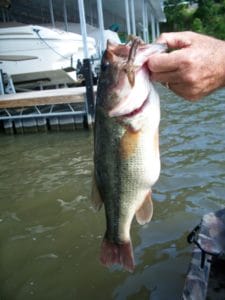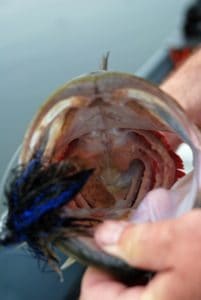by Bill Cooper
Hawg hunters know that February can produce some of the biggest largemouth bass of the year. But it takes knowledge of the correct tactics and a lot of patience to wait it out for four or five big bites of the day. Here’s how.

Jigs and creature baits are great options for the big bass of February. Slow-moving baits are best as bass are sluggish in the cold water.
Lake of the Ozarks, located in central Missouri in the northern part of the Ozark Mountains, is a bass-producing phenomenon. Built in the 1930s to provide electricity to the center of the state, few could have realized that in a couple of decades the lake would attract the attention of bass anglers all over the nation.
The winter scene at Lake of the Ozarks (LOZ) can be brutal. The cold winds and harsh winter weather of February hold all water sports enthusiasts and all but the hardiest of fishermen at bay. However, those fishermen who venture out in snowsuits, heavy gloves and insulated helmets experience some of the best bass fishing of the year, especially for big bass.
LOZ is famous for its springtime bass fishing, but many say that the fishing is even better in February before the spring warm up. At least the absence of crowds provides far more favorable conditions for anglers. Fishermen have the opportunity to pursue bass under some of the most natural conditions of the year.
No discussion of bass fishing at LOZ is complete without mentioning the numerous boat docks at waters edge. Anglers are naturally drawn to the structures because they are the most visible cover on the lake. Most of the year, the docks are very productive, including February. However, the best cold-weather bass fishing can be found far offshore on secondary points in major tributaries and on main-lake points. These features attract baitfish and also funnel currents. Therefore, bass concentrate over these deep structures.
Anglers need to search the flats and higher up on the points when the floodgates are open at both ends of the lake. The flowing current and accompanying stained water brings bass out of the deeper water. Throw in a couple of warm days, and fish will follow baitfish back to the coves. This scenario creates the perfect setup for tossing baits to the sunny corners of docks.
Born and raised at LOZ, Keith Enloe now has 30 years under his belt as a bass fishing guide. A big man, Enloe has a soft nature and a softer place in his heart for big bass. He grins as his voice spikes when talking about big LOZ bass in February.
From his three decades of guiding on the lake, Enloe has zoned in on the north shore and the Gravois arm for his February bass hunts.
“Water clarity is the key,” he began. “Water clarity and temperature determine how deep I fish. On the average, I fish from 12 to 25 feet deep during cold weather.”
Lucky Craft and Smithwick Rogue jerkbaits are Enloe’s starting lineup for February bass.
“I like to run these baits over brushpiles, which I have marked on my GPS unit,” he said.
If the surface temperatures dip below 40 degrees, there will likely be a shad kill on the lake.
“When the water temperature is 38 to 39 degrees, I slowly bring my baits over the structure to imitate a dying shad.”
Although the lures Enloe utilizes are referred to as jerkbaits, he uses a different technique.
“Bass are lethargic in cold water and are not going to chase a bait. I literally pull the bait slowly rather than jerk it. I drag it 12 to 18 inches and then let it sit for at least 30 seconds and sometimes as long as a minute,” he said.
The technique takes patience, especially for anglers used to the warm-season action of ripping spinnerbaits and walking-the-dog with topwater baits. A good rule of thumb is to follow the old adage: “when you think you have slowed your bait down, slow it down some more.”

A Lucky Craft Pointer jerkbait in Tennessee Shad color is a great option for February bass, but until the water warms, it should be fished very slowly. At Lake of the Ozarks, guide Keith Enloe recommends “pulling” the bait with slow sweeps of your rod instead of jerking it like you would during the springtime.
Enloe says that the suspending Lucky Craft jerkbaits work best for the sitting-still routine.
“Anglers must pay close attention after stopping the bait,” he said. “Often, the line only begins to feel heavy. Bites are usually light. Sometimes, the line sorta jumps. This bite is very difficult for beginners to adjust to.”
As water temperatures climb into the upper 40s, Enloe adjusts his techniques. “It may seem like a subtle difference, but it works,” the expert angler related. “Rather than drag the lure, I pop it and then let it sit.”
For the cold weather months, Enloe prefers his baits in either Tennessee Shad color or Aurora Black with silver sides. The silver side looks like the natural side of a shad. He rigs his reels with 12-pound Maxima and P-Line in the same weight.

Jigs may be the best big-bass bait ever, and February is a great time to methodically work a jig over deep-water structure.
Enloe stated that one of the best things a newcomer to cold-weather bass fishing can do for themselves is to hire a guide. “I still hire a guide myself when I am fishing a new lake or trying a new technique.”
By late March, LOZ bass begin moving out of the main lake.
“When water temperatures reach the 48-degree range, bass head for the deep secondary points off of the main lake,” he said. “When temperatures rise to the 45- to 50-degree mark, bass make the big move. I look for them in softball-sized rocks and along shelf lines. Jigs and Chompers work best under these circumstances. I like to drag ‘em down and shelf hop my baits. Imagine walking down a flight of stairs. Just as you feel your foot make contact with each step, you should concentrate on feeling your bait as you work it slowly down the rock ledges.”
In closing, Enloe stated, “Bass fishing is a blast. I love it and have committed much of my life to it. If fishermen can develop patience, which is 80 percent of the game, the rest of it will fall into place.”
The Union Sportsmen’s Alliance website is designed to provide valuable articles about hunting, fishing and conservation for members of AFL-CIO affiliated labor unions and all sportsmen and sportswomen who appreciate hunting and fishing and want to preserve our outdoor heritage for future generations. If you would like your own story and experience from the outdoors to be considered for our website, please email us at [email protected].



